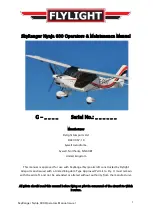
Propeller Owner’s Manual
139
DESCRIPTION AND OPERATION
61-00-39
Page 2-24
Rev. 17 Apr/20
D. Feathering and Reversing Propellers
HC-( )3( )( )-7( ) Series (Beta Valve System)
Refer to Figures 2-8 and 2-9. The propellers described in
this section are constant speed, feathering and reversing.
They use a single oil supply from a governing device to
hydraulically actuate a change in blade angle. The propellers
have three blades, and are used primarily on Allison
250B17( ) series turbine engines.
Propeller blades and bearing assemblies are mounted on the
arms of a steel hub unit (Figure 2-2) and are held in place by
two-piece blade clamps. A cylinder is threaded onto the hub,
and a feathering spring assembly is installed in the cylinder.
A piston is placed over the cylinder and is connected by a
link arm to each blade clamp. Propeller blade angle change
is accomplished through the linear motion of the hydraulically
actuated piston that is transmitted to each blade through the
link arms and blade clamps.
While the propeller is operating, the following forces are
constantly present: 1) spring force, 2) counterweight force,
3) centrifugal twisting moment of each blade, and 4) blade
aerodynamic twisting forces. The spring and counterweight
forces attempt to rotate the blades to higher blade angle,
while the centrifugal twisting moment of each blade is
generally toward lower blade angle. Blade aerodynamic
twisting force is usually very small in relation to the other
forces and can attempt to increase or decrease blade angle.












































